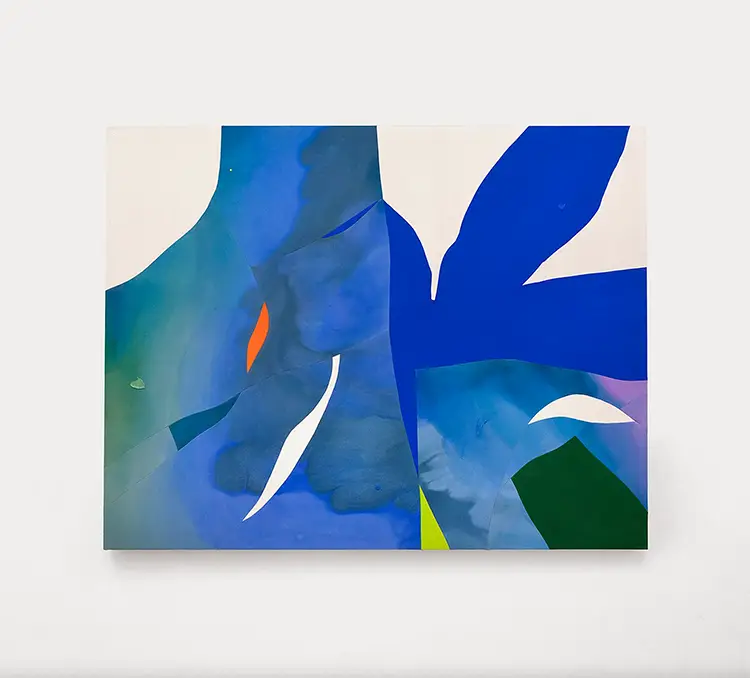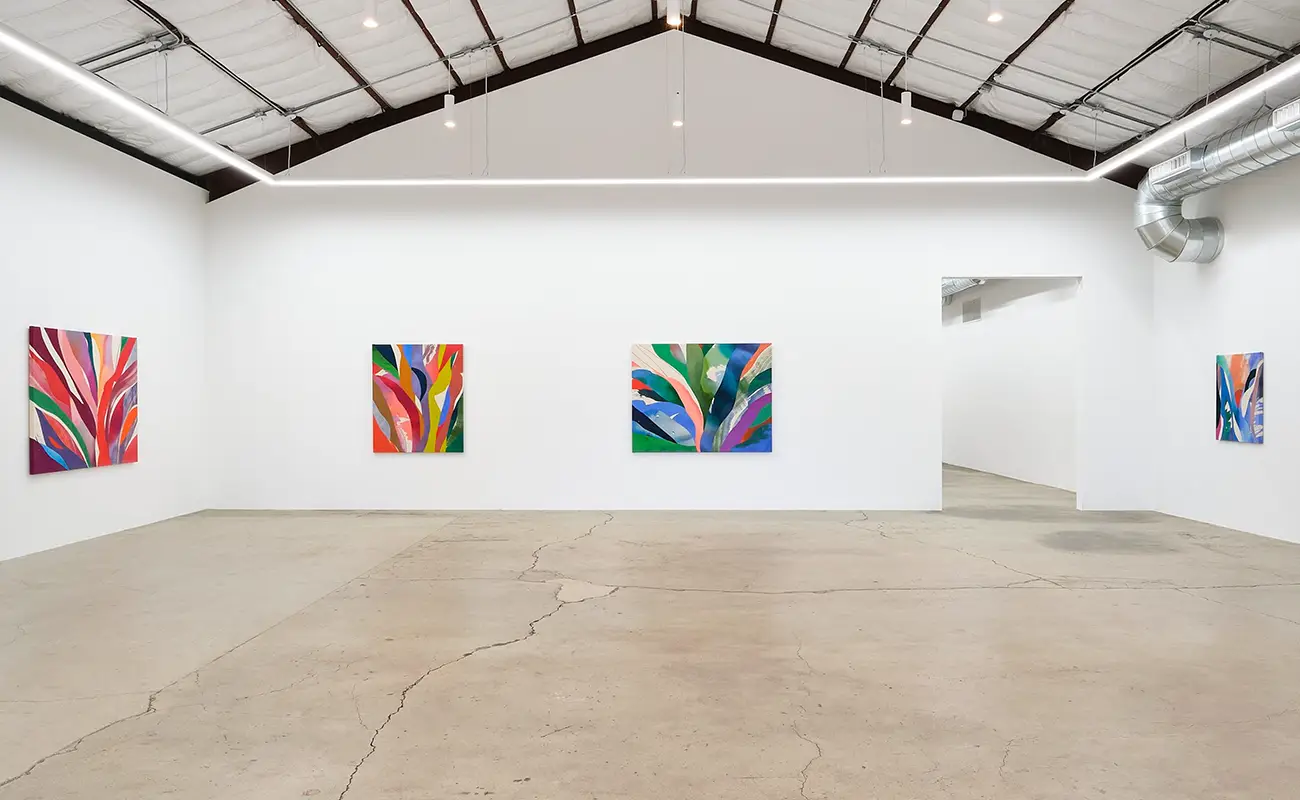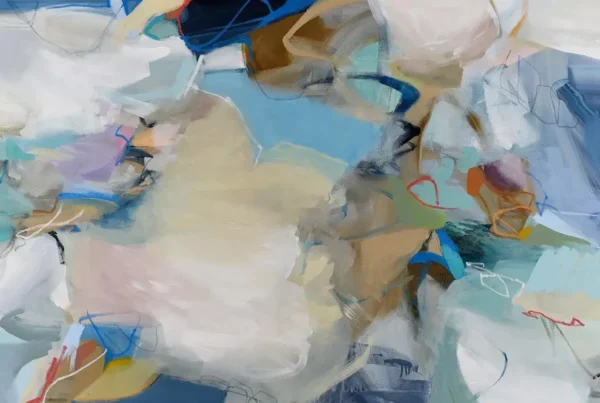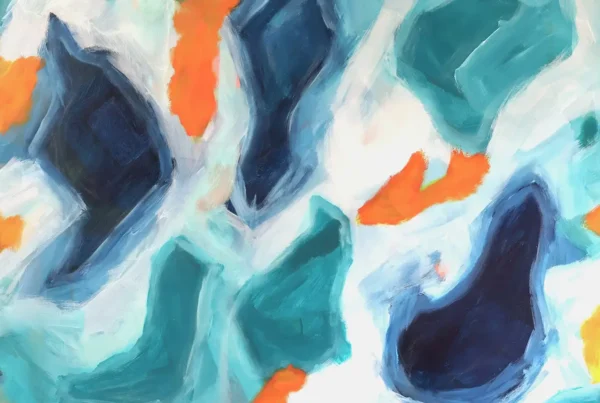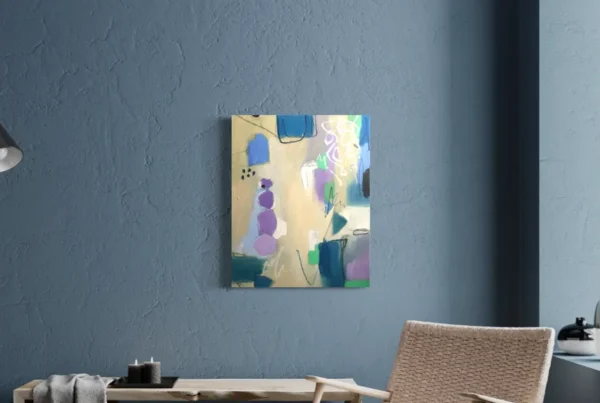A Painter of Movement, Memory, and Material
Heather Day, born in 1989 in Honolulu, Hawaii, crafts abstract paintings that are as much about perception as they are about pigment. Now based in the Mojave Desert, her work investigates the junction where sensory memory meets the visceral experience of the physical world. Through fluid washes, scraped surfaces, and richly colored fields, Day’s paintings offer more than visual engagement—they prompt a kind of personal excavation, encouraging viewers to map their own emotional landscapes onto her compositions. Her practice bridges analog technique and digital intervention, from stitching canvases by hand to animating brushstrokes in augmented reality. Day’s commitment to artistic evolution places her among contemporary abstraction’s most compelling figures, where process and instinct coalesce into bold new visual languages.
Her creative output resists linearity. Instead, Day works with what she calls a library of past and present painted forms—fragments of previous works that are cut apart, restructured, and sewn into new configurations. This ongoing interplay of destruction and rebuilding reflects her deeper interest in control, chaos, and chance. Inspired by natural phenomena such as the shifting desert light or the texture of wind across sand, her paintings distill ephemeral experiences into layered visual narratives. Her materials—acrylic, canvas, pigment, even sand—are orchestrated into tactile compositions that oscillate between tension and release. The outcome feels at once impulsive and composed, speaking to the unpredictable nature of memory and sensation.
Day’s work is not easily confined to a single genre or methodology. While rooted in painting, her practice extends into digital experimentation, including collaborations with Facebook and Google to create augmented reality experiences. These ventures push her formal concerns into immersive space, underscoring her belief that abstraction can be a sensory translation—not only of what we see but of how we hear, feel, and move. Her embrace of technology adds another layer to her visual storytelling, challenging conventions and expanding the possibilities of what painting can be in the 21st century. Whether viewed on canvas or through a screen, her compositions prompt a reconsideration of abstraction’s function—as both document and interpretation of the world’s fleeting details.
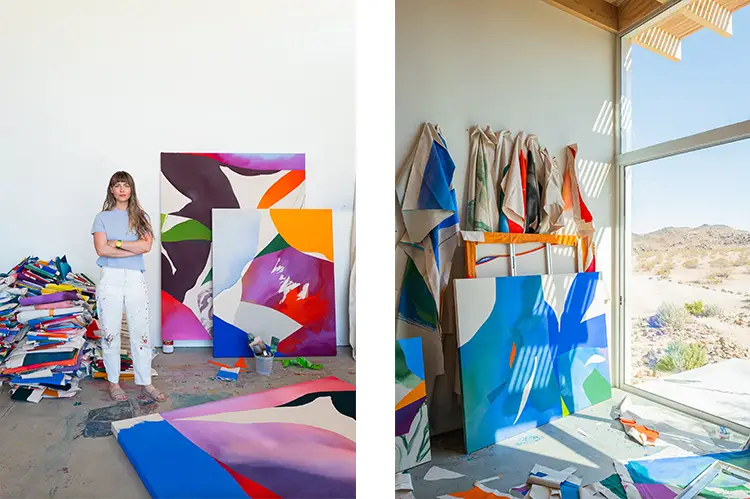
Heather Day: Fractured Canvases, Unified Vision
A hallmark of Heather Day’s practice lies in her method of deconstructing and reconstructing paintings to form hybrid compositions. Since 2020, Day has developed a unique process that involves cutting apart existing canvases—some dating back several years—and stitching them together with new works. This transformative approach emerged during the isolation of the pandemic, a time she describes as granting her the freedom to abandon old formulas and begin anew. Rather than discard what no longer served her, Day repurposed past efforts, giving them new meaning through juxtaposition and reassembly. She refers to this as building a relationship between her present and former selves—a dynamic dialogue etched directly into the seams of her work.
In her Mojave Desert studio, Day treats the floor as a compositional space. Here, fragments are laid out like puzzle pieces inside the perimeter of a stretcher bar, which acts as both boundary and frame. Each final piece is a visual choreography, where stains, washes, and pigment fields collide with stitched seams and directional marks. Her performances with paint are evident in the traces of flicks, pours, and drips—gestures that echo the kinetic intensity of her working process. The end result is neither wholly spontaneous nor tightly planned. Instead, her paintings balance intuition with structure, a push-and-pull between reckless energy and formal discipline. A recent work incorporates five canvases painted over four years, including a silver-and-red panel from a previous exhibition—underscoring her commitment to artistic continuity through fragmentation.
Day’s process also has personal dimensions rooted in her lived experience. She likens the reconfiguration of canvases to how she processes the world with dyslexia—seeing ideas not as linear but as interlocking units that demand reordering. This way of thinking informs her entire approach to abstraction, where visual logic is built from dissonance and surprise. In her words, it’s about finding comfort within discomfort and letting seemingly incompatible elements find cohesion. Whether dealing with color choices that pit fuchsia against cadmium red or with textures that contrast soft washes with raw grit, Day continually challenges viewers to reconsider harmony, not as perfection, but as resolution through conflict.
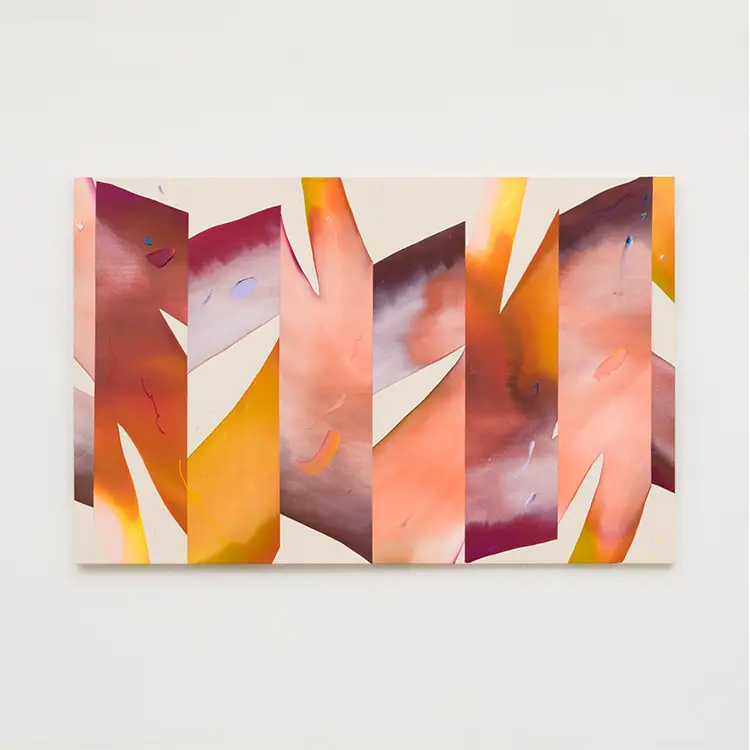
Painting the Senses, Not the Scene
Heather Day’s connection to the natural world is less about representation and more about transference. Her paintings do not depict the desert surrounding her Joshua Tree home, but they are saturated with its presence. From the shimmering heat of midday to the quiet luminescence of twilight, her compositions channel environmental shifts into sensory impressions. This approach stems from Day’s desire to translate not just what she sees, but what she experiences in totality—sound, movement, temperature, light. Her goal is to compress the fleeting nuances of a moment into the permanence of pigment, offering a spatial-temporal echo rather than a literal image. She likens this ambition to Claude Monet’s Haystacks, where changing light and season are captured across series, transforming everyday scenes into meditations on impermanence.
Her studio itself, built partially into the earth below her home, is engineered for observation and immersion. With massive glass doors framing ancient rock formations and a climate that alters how quickly paint dries, the studio is both sanctuary and collaborator. Day’s routine begins early, often just steps away from where she slept the night before, allowing her to remain fully embedded in her surroundings. Every aspect of her practice is influenced by this immersive relationship with place—not just the visible landscape, but its atmosphere and material presence. During walks, she has begun collecting sand from her property, integrating the desert’s actual grit into her work. Though she later pivoted to pumice for durability, the impulse to literally embed her environment into her canvases signals an evolving, porous boundary between art and life.
The sensory depth of Day’s practice extends beyond visual elements to conceptual ones. Sound, for instance, plays a key role in how she understands and composes her works. She often asks: how does a creaking tree branch in the wind become a line of paint? How can light slicing through a window at dusk become a vibrating wash of color? These questions animate her visual storytelling and keep her compositions grounded in experience rather than abstraction for its own sake. Her paintings thus become more than surfaces; they act as vessels for emotional recall, where each viewer brings their own memories to interpret what they see. Through this interplay, Day offers a unique kind of engagement—art as a form of embodied memory, shared across pigment, stitch, and silence.
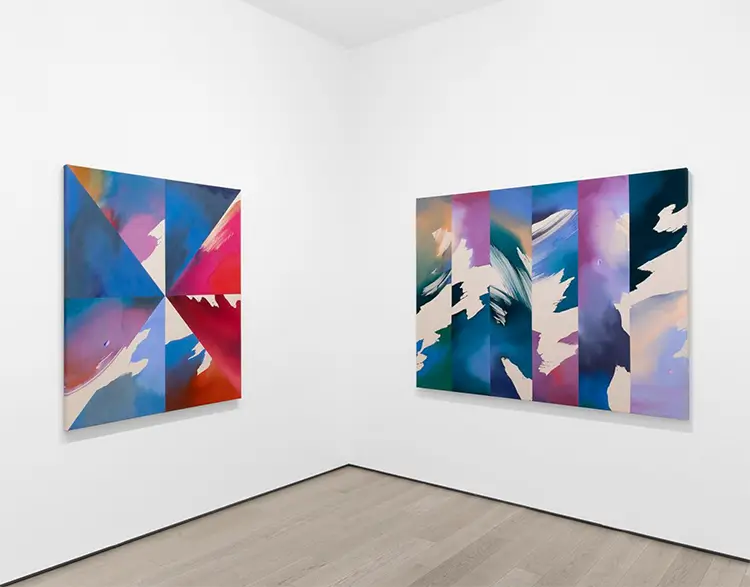
Heather Day: Threads of the Past, Motions of the Present
Heather Day’s biography reveals a path shaped by movement, resilience, and early artistic conviction. Born in Hawaii, she spent her formative years navigating a constantly shifting landscape—living in Japan, Washington D.C., and eventually Chicago, where she finished high school under challenging circumstances. The instability of her adolescence became the foundation for her self-reliance and creativity. Day found sanctuary in an arts high school, where community and expression offered both refuge and direction. During this time, art became more than a passion—it was a way to construct personal meaning in the face of uncertainty. This formative experience echoes throughout her work today, where memory, fragmentation, and reconstruction play central roles.
Day’s interest in sewing predates her stitched canvas works. While attending the Maryland Institute College of Art, she worked at a local furniture company and began experimenting with discarded fabric swatches—painting, stitching, and repurposing them in her own pieces. Though she later moved to traditional canvases, the tactile, physical relationship to materials persisted. This tactile awareness would later reemerge in her stitched paintings, suggesting that even early explorations left lasting impressions on her methods. The continuity between past and present is vital to Day’s vision. Her stitched compositions are not just about visual intrigue—they’re also about history, time, and the act of making meaning from disparate parts.
Color, for Day, is another narrative device. Her palettes are intentionally confrontational, often combining hues that resist harmony but generate energy. She describes her use of color as casting characters in a drama: a bold magenta might dominate a scene while a deep cobalt offers quiet contrast, and a jarring cadmium red serves as antagonist. These interactions become stories in themselves—each painting a set of relationships that shift with every glance. By pairing visual contradiction with emotional intent, Day maintains a sense of risk in her studio practice. Whether integrating gritty texture or manipulating space through animated sequences, she never settles into comfort. Her work insists on evolution, experimentation, and the constant reimagining of what a painting can be, both to its maker and its audience.
